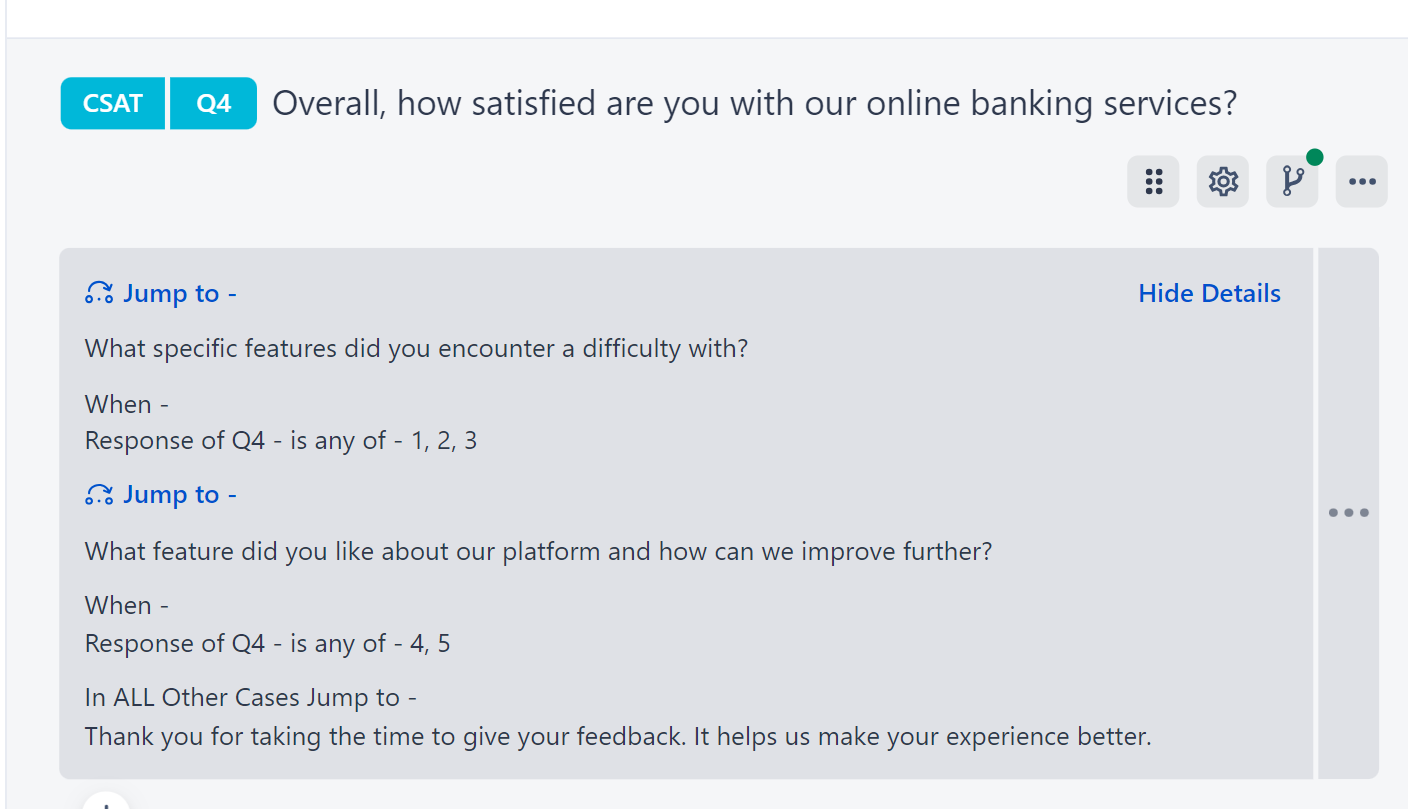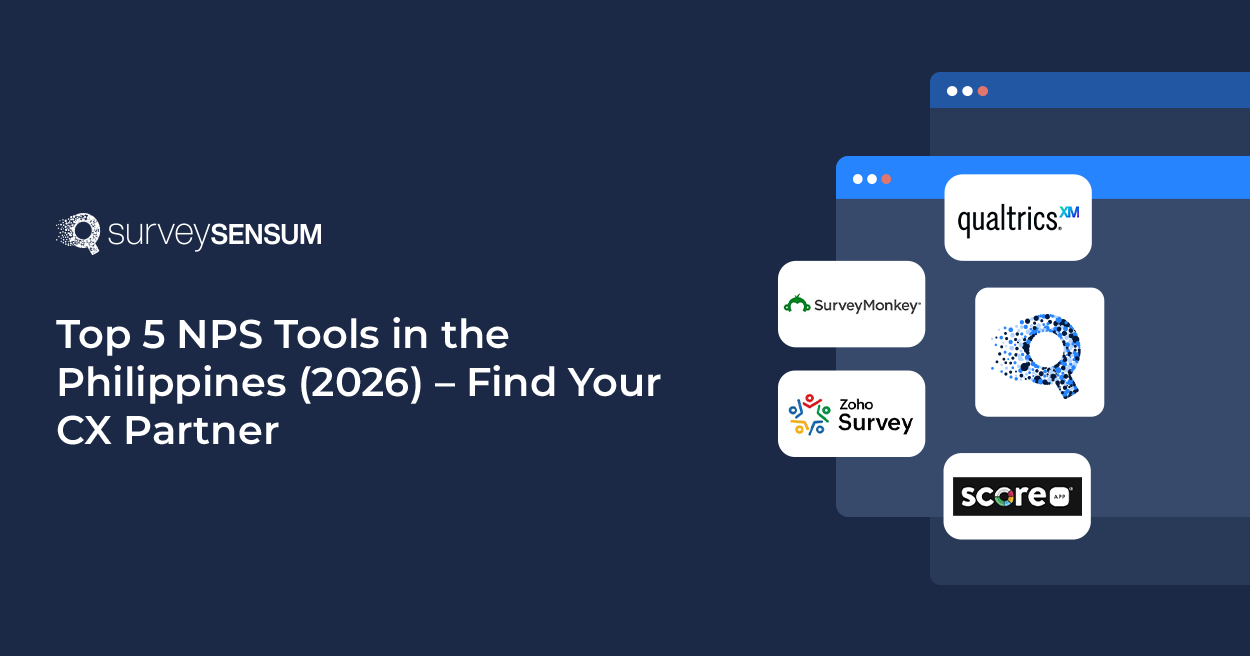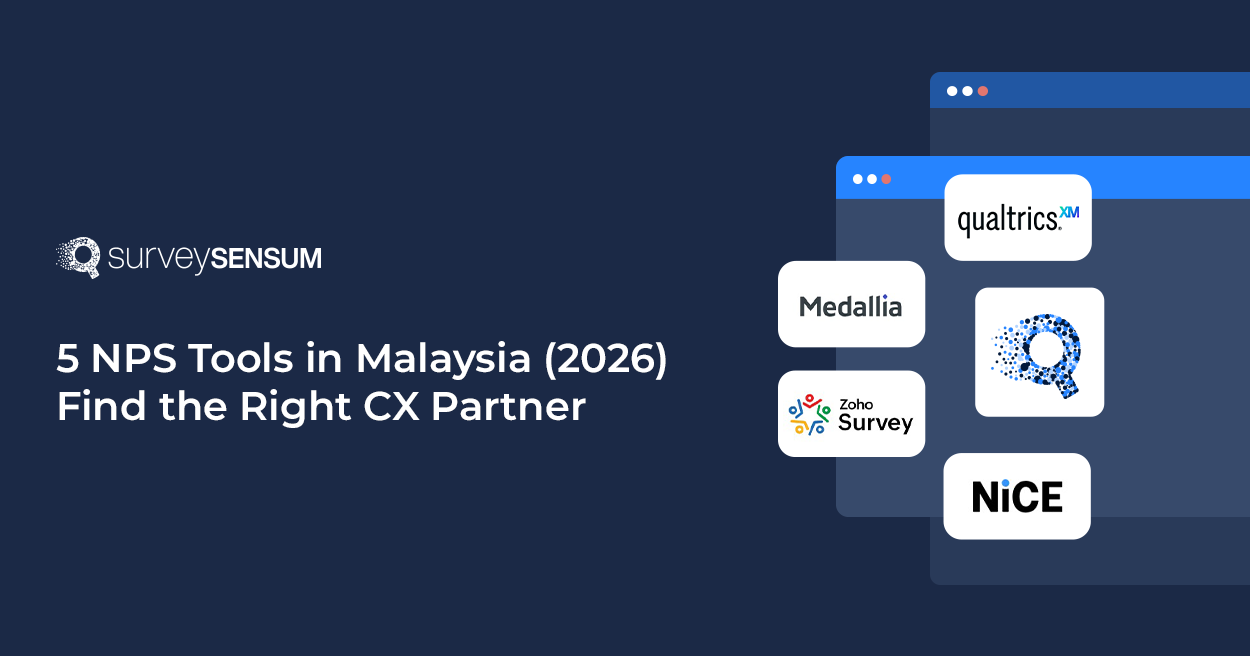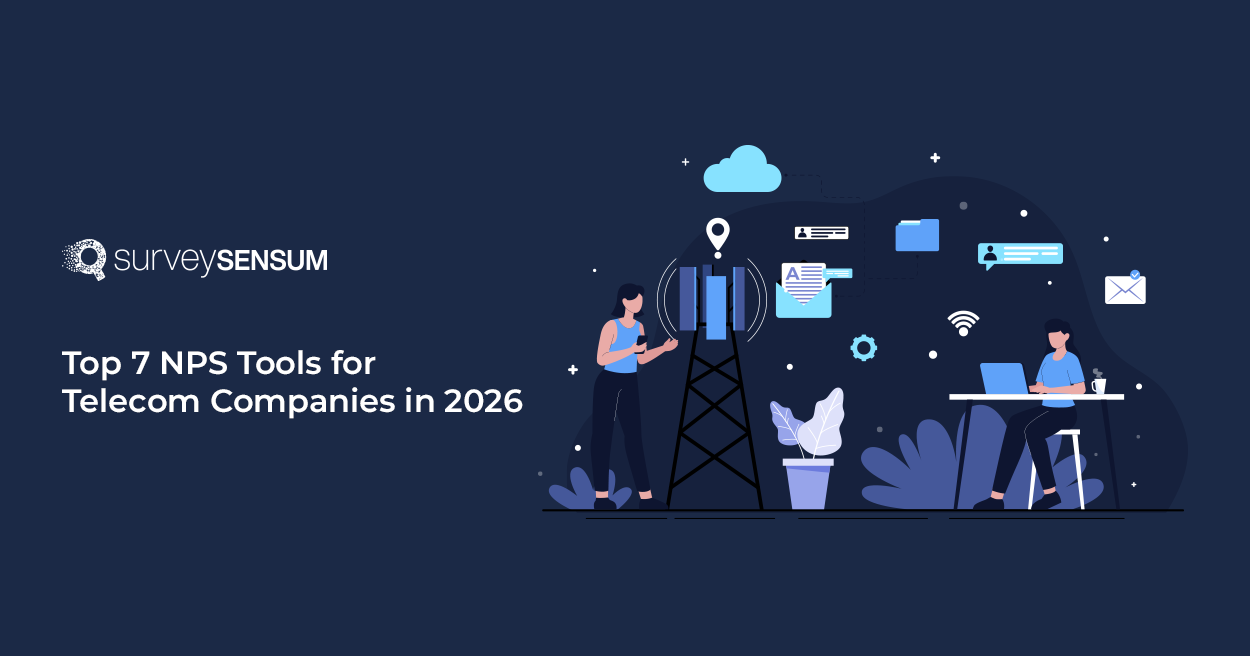

All a company wants is to give its customers an experience that’s memorable, right?
And this goes beyond just creating memorable customer experiences. It also contributes significantly to a company’s growth.
Don’t believe me? Well, hear this- businesses with excellent CX can achieve revenue growth rates 4-8% higher than their competitors,
Now, the question arises – how does one create such experiences?
Well, the answer is Net Promoter Score!
NPS provides a clear, quantifiable measure of customer satisfaction and loyalty, and identifies areas for improvement based on customer feedback and insights.
But the problem lies in the fact that a lot of companies are using NPS software just because everyone else is doing it – but are not actually USING that feedback. Resulting in losing out on all the advantages of an NPS program.
So, in this article, we talk about all the ways in which NPS surveys can help you enhance your customer experience which in turn will boost your business performance.
But first, let’s get to know more about the importance of NPS in CX.
How is NPS Important for CX?
NPS is a valuable metric in understanding and improving customer experience as it tells a company a lot about its customer loyalty. So read further to find the reasons why NPS is crucial in measuring customer loyalty and how it influences overall CX:
1. Measuring Customer Loyalty:

NPS categorizes customers into Promoters (score 9-10), Passives (score 7-8), and Detractors (score 0-6) based on their likelihood to recommend a product or service to others. This segmentation provides a clear picture of customer loyalty levels and helps in crafting actionable strategies that help you boost your business.
2. Influence on Revenue:
A higher NPS score is directly linked to better CX outcomes. Not just that, according to Bain & Company, companies with high NPS tend to grow at more than twice the rate of competitors with lower scores. Additionally, NPS is a leading indicator of customer retention and revenue growth, making it a strategic tool for improving CX.
3. Influence on CX:
A high NPS indicates that customers are likely to recommend the brand to others, leading to increased word-of-mouth marketing and organic growth. This positive advocacy not only attracts new customers but also fosters a loyal customer base that continues to support the brand over time.
By focusing on improving NPS, businesses can identify areas of strength and weakness in their customer interactions, leading to targeted efforts to enhance CX, address customer pain points, and ultimately drive business success through higher customer retention, increased referrals, and improved brand reputation.
→ Read further on to learn about how to improve NPS.
Craft effective Surveys in under 5 minutes and enhance your CX in no time with SurveySensum!
After knowing the importance of NPS, you also have to know the strategies to employ to enhance CX, right?
NPS in CX: 12 Strategies to Craft Customer Experiences That Stick
1. Don’t Forget to Use NPS Tools:
Using the best NPS software tools can significantly contribute to creating a memorable customer experience by providing actionable insights and facilitating continuous improvement. Here’s how:
- In-built templates for quick surveying: These tools provide pre-designed survey templates tailored for NPS surveys. This streamlines the survey creation process, ensuring that surveys are easy to set up and administer, saving time and effort for CX teams.
- Real-Time Feedback: NPS tools allow for real-time feedback collection, enabling businesses to gather insights and take action on them in time.
- Ticketing System to close the feedback loop: NPS tools have ticketing systems, allowing businesses to convert feedback into actionable items or tickets. This helps in closing the feedback loop by ensuring that customer feedback leads to concrete actions or resolutions, enhancing customer satisfaction.
- NPS Reports for strong analysis: NPS tools generate comprehensive reports and analytics based on survey responses. These reports include NPS scores, trends over time, and benchmarks against industry standards. Such insights enable businesses to conduct in-depth analyses and identify areas for improvement in CX.
- Text Analytics to identify common issues: Advanced NPS tools include text analytics capabilities that automatically analyze open-ended feedback comments. This feature helps in identifying common issues, sentiments, and keywords, providing deeper insights into customer experiences and pain points.
- NPS Expert support for overall NPS program: Many NPS tools, like SurveySensum, offer expert support and guidance to help businesses optimize their NPS programs. This includes best practices for survey design, data interpretation, and strategies for improving NPS scores and overall CX.
- Role-based dashboards to share relevant insights: NPS tools provide role-based dashboards that allow different stakeholders, such as CX managers, marketing teams, or executives, to access relevant insights and metrics. This ensures that decision-makers have access to actionable data to drive CX improvements effectively.
Leveraging NPS tools enables businesses to proactively manage CX, address customer needs effectively, foster engagement and loyalty, and ultimately create memorable experiences that leave a lasting positive impression.
2. Incorporate Personalization in Your NPS Program:
Why is it important: Incorporating personalization in your NPS program is essential for effectively engaging with your audience as 80% of respondents say they are more inclined to do business with an organization that delivers tailored experiences.
By addressing respondents by their name, tailoring questions based on their previous interactions or preferences, and customizing survey content to their specific interests, you demonstrate that their feedback is important and relevant.

How to achieve it:
- Demographic Segmentation: Utilize data on demographic characteristics such as gender, age, location, occupation, etc., to segment your audience into relevant groups. Tailor survey questions and content based on these segments to ensure relevance and resonance with each group’s specific interests, needs, and experiences.
For example:
For Female Customers:
- On a scale of 1 to 10, how likely are you to recommend our product variety for women’s fashion to a friend or colleague?
- On a scale of 1-10, how likely are you to recommend our Indo-Western sarees to a friend or colleague?
- Personalized Follow-up Questions for NPS Segments: After categorizing respondents into promoters, detractors, and passives based on their NPS, craft personalized follow-up questions for each segment.
- For promoters, ask what specific features or aspects they appreciate most..
- For detractors, inquire about the main reasons for their dissatisfaction and areas where you can improve.
- For passives, seek insights into how you can make their experience better.
Tailoring follow-up questions based on NPS segments allows you to delve deeper into the unique experiences and perspectives of each group, leading to more actionable feedback and targeted improvement strategies.

Encourage further engagement by inviting the customer to reach out if they have any additional feedback, questions, or concerns. Provide contact information or links to relevant resources to make it easy for them to connect with your customer support team or provide further input.
For example: Dear [Customer’s Name],
We appreciate your feedback! If you have any additional comments, questions, or concerns, please don’t hesitate to reach out to us. Our customer support team is here to assist you.
You can contact us directly at email@example.com or call us at [Phone Number]. We value your input and are committed to continuously improving your experience with us.
Thank you again for taking the time to share your feedback!
3. Focus on Detractors:
Make it a priority to reach out to detractors and resolve their issues. Turning detractors into promoters is hugely beneficial to your NPS and overall customer experience. Here are some strategies on how to focus on detractors effectively:
1. Promptly Respond with Empathy: Reach out to detractors promptly after receiving their feedback. Show empathy and understanding for their concerns, and assure them that their feedback is valued and will be addressed seriously.
2. Listen and Understand: Listen actively to detractors to understand the root causes of their dissatisfaction. Ask questions to gather detailed insights into their experiences and what could have been done better.
3. Offer Solutions: Provide personalized solutions or resolutions to address detractors’ specific issues. This may involve offering refunds, replacements, discounts, or additional support to rectify their negative experiences and regain their trust.
4. Follow-Up and Close Feedback Loop: Follow up with detractors after implementing solutions to ensure their satisfaction. Ask for feedback on the resolution process and how their experience has improved. Use this feedback to close the feedback loop and make further improvements to prevent similar issues in the future.
4. Implement Changes Based on Feedback:
Taking feedback without taking action on it defeats the purpose of gathering customer feedback. It shows a lack of responsiveness, potentially leading to frustration and lower response rates in future surveys. Taking action on feedback is essential for improving customer experience and here’s how you can achieve it:
- Focus on Analysis: Text analytics is a powerful tool for implementing changes based on feedback. By analyzing text data from customer feedback, businesses can identify recurring themes, sentiment trends, and specific areas of concern or satisfaction. This analysis provides actionable insights that can guide decision-making and drive targeted improvements.
- Promptly Respond with Empathy: Reach out to detractors after receiving their feedback. Show empathy and understanding for their concerns, and assure them that their feedback is valued and will be addressed seriously. Ask questions to gather detailed insights into their experiences and what could have been done better.
- Engage Cross-functional Teams: Involve cross-functional teams such as product development, customer service, marketing, and sales in the feedback analysis process. This brings diverse perspectives to the table, fosters alignment across departments, facilitates informed decision-making, and ensures that feedback is effectively translated into actionable strategies.
- Develop Action Plans: Based on the insights gathered, develop actionable plans to address the feedback. This involves making changes to existing products/services, improving customer support processes, refining marketing strategies, or enhancing user experiences.
- Implement Changes: Implement the necessary changes based on the action plans developed. Ensure that these changes are aligned with customer needs and preferences as identified through the NPS feedback.
- Communicate to the customers that actions have been taken: Communicating to customers that actions have been taken based on their feedback is essential for building a strong relationship and providing assurance that their voices are heard and valued. This transparent communication fosters a positive perception of the brand and fosters customer loyalty
For example:
Feedback: Customers reported difficulties in navigating your website’s checkout process, leading to abandoned carts and frustration.
Thorough Analysis: You conducted a comprehensive examination of the website’s user experience by reaching out to customers who gave you feedback to understand the issue in detail.
Identification and Delegation: Based on feedback and analysis, you identified several technical issues which you shared with the tech team to resolve.
Resolution: In response, the tech team redesigned the checkout process to address these issues. Changes included streamlining the process, making it more intuitive and mobile-friendly, and clarifying instructions to make them easier to follow.
Communicate to Customers: The tech informed the CX team of the implemented changes which then informed the customers, via email, about the changes made on their feedback.
SurveySensum’s CX experts help you with the end-to-end process of your NPS program – from survey creation to feedback analysis. The objective is to give you those actionable insights that directly impact your bottom line.
5. Communicate Improvements:
Make sure to let your customers know about any changes that have been made based on their feedback. This increases their loyalty and turns them into promoters.

For example, Apple often communicates product improvements based on customer feedback through their software updates. For example, they may highlight new features or enhancements in iOS or macOS that directly address user suggestions or complaints, demonstrating their responsiveness to customer input.
6. Increase Response Rate:
Increasing the NPS response rate ensures that the data collected is more representative of the target audience, leading to more accurate analyses and actionable recommendations.
How to Increase Response Rate:
- Short and Concise Surveys: Keep your surveys short and concise to avoid respondent fatigue. Focus on essential questions that directly relate to NPS, customer satisfaction, and areas for improvement.
- Accessibility Across Platforms: Ensure that your survey is easily accessible on multiple platforms, including mobile devices, tablets, and desktops. Use responsive design to optimize the survey layout for different screen sizes.
- Personalized Invitations: Personalize survey invitations with the recipient’s name and mention the importance of their feedback. Explain how their input will contribute to improving the customer experience.
- Timing and Frequency: Decide how often you want to send NPS surveys. The frequency can vary depending on your industry, and customer base. Avoid surveying too frequently to prevent survey fatigue.
- Incentives (Optional): Consider offering incentives such as discounts, vouchers, or entries into a prize draw to encourage participation. However, ensure that incentives do not bias responses or artificially inflate scores.
→ Read more about when to send an NPS survey.
7. Continual Monitoring:

NPS score should be tracked over time, not just as a one-off measurement. Constant monitoring helps you to understand trends, identify issues, and act accordingly.
Not doing continual monitoring of NPS scores tracked over time can lead to several negative consequences:
1. Missed Insights: Without ongoing monitoring, businesses may miss important trends, patterns, or changes in NPS scores that could indicate shifts in customer satisfaction or loyalty levels. This lack of insight can result in missed opportunities for improvement or addressing emerging issues.
2. Ineffective Decision-Making: It provides valuable data for making informed decisions about CX strategies, product/service enhancements, and customer engagement initiatives. Without up-to-date NPS data, businesses may make decisions based on outdated or incomplete information, leading to ineffective strategies.
3. Lack of Accountability: Monitoring NPS scores over time holds teams and departments accountable for CX performance. It allows businesses to track the impact of initiatives or changes implemented based on previous feedback. Without this accountability, there may be a lack of clarity on the effectiveness of efforts to improve customer experience.
8. Don’t Indulge in NPS Gaming:
NPS gaming refers to practices aimed at artificially inflating Net Promoter Scores through manipulative tactics, such as biased survey sampling, incentivizing positive responses, or discouraging negative feedback. Stopping NPS gaming is crucial for creating a memorable CX because it ensures that the feedback collected is genuine and reflective of actual customer sentiment. Here’s how you can stop NPS Gaming:
- Transparent Survey Practices: Ensure transparency in survey practices, including clear communication about the purpose of the survey, confidentiality of responses, and the importance of honest feedback.
- Avoid Incentives for Positive Responses: Refrain from offering incentives or rewards for providing positive NPS scores to prevent biased feedback.
- Encourage Balanced Feedback: Encourage customers to provide balanced and honest feedback by asking open-ended questions and allowing them to express both positive and negative experiences.
- Regular Monitoring and Analysis: Continuously monitor NPS trends and analyze feedback patterns to detect any anomalies or suspicious activity that may indicate gaming.
9. Educate Your Team:
Ensure that all staff understand the importance of NPS and how it can be used to build customer-centricity. Everyone plays a role in shaping customer experiences. Here’s how you can achieve it:
- Top-Down Approach: Start by showing the leadership the impact of NPS on a small scale and then strategize with them to set the same tone for the entire organization.
- Comprehensive Training: Provide training sessions and workshops for all staff to learn about NPS and its influence on customer experiences. Include real-life examples and case studies to make the training practical and engaging.
- Empowerment Through Knowledge: Help employees understand how their actions directly impact NPS scores. Show them how providing excellent customer service, addressing feedback, and going the extra mile can improve NPS.
10. Color-Code Your NPS Surveys:

Color-coding NPS surveys can enhance readability and interpretation, making it easier for stakeholders to quickly grasp key insights.
By using a color-coded system survey results become visually intuitive, allowing for immediate identification of customer sentiment levels. This visual representation not only simplifies data analysis but also facilitates effective communication of NPS trends and patterns across teams and departments.
However, not everyone supports this as some believe this can generate biased data as respondents tend to get influenced by the colors of their responses.
11. Celebrate Successes:
When your NPS score improves, celebrate the wins with your team. Team encouragement is essential when celebrating successes related to NPS score improvements. Recognizing and celebrating achievements not only boosts team morale but also reinforces a culture of continuous improvement.
Here are some strategies on how to achieve that:
- Acknowledge Contributions: Recognize and acknowledge the efforts of team members who contributed to improving the NPS score. Highlight specific actions or initiatives that led to positive change.
- Public Recognition: Celebrate wins publicly within the team or organization. Share the NPS score improvements and the team’s role in achieving them during meetings or through internal communications.
- Reward and Appreciation: Consider rewards or incentives to show appreciation for the team’s hard work. This could include bonuses, extra time off, or even small tokens of appreciation like gift cards or personalized notes.
- Feedback and Reflection: Use the improved NPS score as an opportunity for feedback and reflection. Discuss what worked well, what strategies were most effective, and how the team can continue to improve in the future.
- Team Building Activities: Organize team-building activities or events to celebrate the success together. This could be a team lunch, a virtual happy hour, or a fun outing to reward and bond as a team.
Also, do not forget to share the success with your customers, especially those who gave you valuable feedback!
12. Create NPS Champions:
Creating NPS champions involves nurturing promoters to become brand activists or influencers who can positively influence others and attract more business. Here are 4 strategies on how to achieve this:
1. Engage and Appreciate: Engage with promoters regularly through personalized communication, exclusive offers, and loyalty programs. Show appreciation for their support and advocacy, acknowledging their role in promoting your brand and attracting new customers.
2. Empower with Tools: Provide promoters with tools and resources to amplify their advocacy, such as branded content, referral links, or social media assets. Encourage them to share their positive experiences with others and provide guidance on how they can effectively communicate the value of your products or services.-
Dear [Promoter’s Name],
Thank you for being a valued customer and for your enthusiastic support of our brand! We believe that your positive experiences can inspire others to discover the value of our products/services.
To help amplify your advocacy, you can access our branded content, referral links, social media assets, and promotional materials.
Thank You for your continued support.

3. Facilitate Networking: Foster a community of promoters where they can connect, share experiences, and collaborate. Organize events, forums, or online groups where promoters can interact, exchange ideas, and support each other’s efforts in promoting your brand.
4. Recognize and Reward: Recognize the contributions of NPS champions publicly and reward them for their advocacy efforts. Offer incentives, rewards, or special privileges to top promoters, such as early access to new products, VIP experiences, or exclusive events. This not only motivates champions to continue advocating but also inspires others to become brand activists.
→ Read more about how to create Brand Advocates!
Now that you know all the strategies involved in enhancing your CX, what’s the point in waiting? Deploy your NPS surveys with SurveySensum today!
How to Improve NPS To Enhance CX?
Improving NPS is crucial for businesses because it directly correlates with customer loyalty, satisfaction, and long-term profitability. Here’s how to get there effectively:
1. Close the Feedback Loop: Actively follow up with customers who provide feedback, especially detractors, to resolve their issues and gather further insights. Closing the feedback loop demonstrates responsiveness and a commitment to addressing customer concerns.
2. Focus on Root Causes: Identify and address the root causes of low NPS scores rather than just addressing symptoms. This involves analyzing feedback data, conducting root cause analysis, and implementing targeted improvements in areas that have the most significant impact on customer satisfaction.
3. Empower Employees: Provide training, tools, and autonomy to frontline employees to handle customer issues effectively and deliver exceptional service. Empowered employees are more likely to create positive experiences that contribute to higher NPS scores.
4. Incorporate Feedback into Decision-Making: Use NPS feedback as valuable input in decision-making processes, such as product development, service enhancements, and strategic planning. Incorporating customer feedback ensures that business decisions are aligned with customer needs and preferences.
5. Continuous Monitoring and Improvement: Continuously monitor NPS scores, track trends over time, and iterate on improvement initiatives. CX is a dynamic process, and ongoing monitoring and improvement efforts are essential for sustaining high NPS scores and enhancing overall CX.
→ Read more about how to improve NPS strategies to enhance CX.
NPS and the Future of CX
NPS is evolving in the digital age, adapting to new CX management strategies. Predictions suggest NPS will integrate with advanced analytics and AI-driven insights for more precise customer sentiment analysis. Harvard Business Review forecasts that by 2025, 80% of customer service interactions will be handled by AI, enhancing NPS feedback processing and real-time response capabilities. This integration aims to elevate CX, leading to increased customer satisfaction, loyalty, and business success in the future.
Common Misconceptions About NPS in CX
Common misconceptions about NPS in CX include:
- Viewing it as the sole indicator of customer loyalty or neglecting qualitative feedback.
- Not complimenting NPS with other metrics and qualitative insights for a holistic view of CX.
- Seeing NPS as static; it requires continuous monitoring and action.
Proper implementation involves understanding that NPS is a tool for gauging customer sentiment, guiding improvement efforts, and fostering a customer-centric culture, rather than a standalone measure of success.
Here’s the Lowdown
In conclusion, NPS plays a crucial role in crafting memorable customer experiences by providing valuable insights into customer sentiment and loyalty. While NPS is not the sole measure of CX success, it serves as a powerful tool when integrated with qualitative feedback and other metrics. Understanding the importance of NPS lies in its ability to guide improvements, identify areas for enhancement, and foster a customer-centric culture.
To achieve this, you need to look no further than SurveySensum. SurveySensum is a robust customer feedback tool that will help you circulate your NPS surveys, collect feedback data, and analyze it with AI-enabled features. It will also help you get intuitive insights and craft actionable strategies with its CX consultation services.
FAQs
CX NPS refers to the Net Promoter Score specifically focused on customer experience). It measures the likelihood of customers recommending a company based on their overall experience with its products, services, and interactions. CX NPS is an essential metric in assessing customer satisfaction, loyalty, and advocacy, providing insights into how well a company delivers on its promises and meets customer expectations.
A CX NPS strategy is a comprehensive plan that outlines how a company will use Net Promoter Score specifically focused on customer experience to improve customer satisfaction, loyalty, and overall business performance.
Unlock the power of CX NPS with SurveySensum! Elevate your customer experience strategy to new heights by harnessing insights from customer feedback.

















